Don't wanna be here? Send us removal request.
Text
Assignment 15.4: Basic Prototype
Here is a basic prototype showing off the movement, however no obstacles or pickups are yet added.
Download Link
0 notes
Text
Assignment 15.3: Soundscape
The game will be very “arcadey” so I’d like to use bright and retro styled music and sound effects for my game. I used free sound effects, but the music is from Sonic (to be later changed to something not copyrighted, I just thought the music was a good representative of the design im looking for)
link to soundscape
0 notes
Text
Journal Entry 15.2: Visual Research
At first I was just researching different endless running games, but I decided I wanted to make a slightly different game in the same genre. Much of the visual and gameplay inspiration comes from the game Motherload, an old mining flash game that I used to play. But instead of digging minerals and brining them back up to sell you are simply going to be automatically digging straight down, using left and right to avoid rocks while grabbing gems and ore.
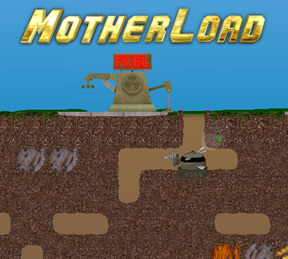
I want to try making this a mobile game, as a portrait screen and tilt controls will work well with the gameplay I envision. I drew up a quick placeholder sketch of the mining device the player will be controlling.
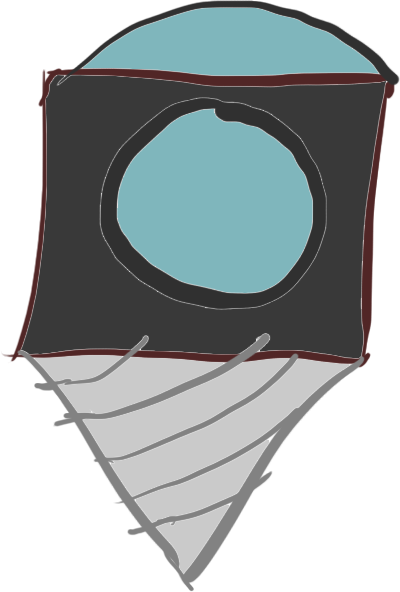
0 notes
Text
Assignment 10: Trick or Treat
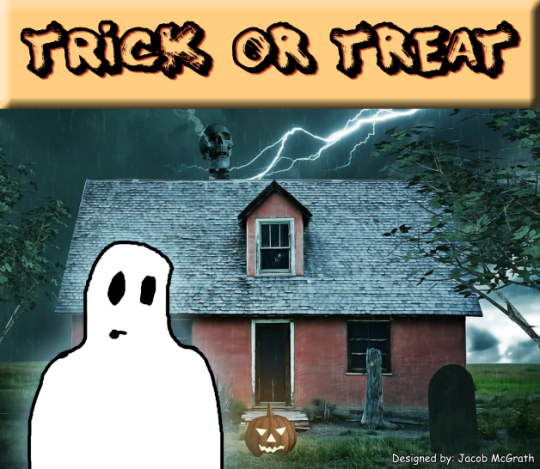
140 Character Description:
Work with or against your friends as a ghost tries to take your Halloween candy! All can go home winners, or it can be one winner-take-all.
Two Paragraph Description:
The game is played in four rounds, with everyone starting off with 8 pieces of candy in bags, hidden from other players. You are allowed to discuss the amount of candy in your bag, but you are not allowed to show your candy to the other players. Each round, the players may choose another player whose candy will be taken by the ghost. Then, they are allowed to strategize on how to leave everyone with the same amount of candy at the end of the game.
This is a game that can be won collaboratively. At the end of the night if everyone has the same amount of candy, then everyone will leave with their candy. Although, if one person has more candy than the others, then they will take everyone else’s candy.
0 notes
Text
Assignment 10.3: Outside Testing
After bouncing around the ideas from my in-class playtesting it was very difficult for me to implement some of the rules without feeling like I was adding a large amount of bloat and rules to the game. My favorite rules that I didn’t implement include the abilities for players to steal other’s candy, and the ability to vote to reveal a player’s candy bag.
Before I went to south to playtest with a random group the mechanics I chose to add included the ghost had the ability to steal from a player of their choice each round (still two players if nobody was pointed at) and the ghost would reveal information to the players each round based on a dice roll. Also I reduced the rounds from 6 to four in order to account for the extra candy being taken each round. The reason I felt like these were good inclusions is that the ghost is also a player and I felt like they had a role that had little interaction with other players. Also, I replace the index cards with small trick or treat bags and got some candy for the players to use in place of tokens.
I played with a group of four random players outside Weed Hall. They seemed to enjoy the lying mechanic very much and had a fun time going back and forth with eachother.
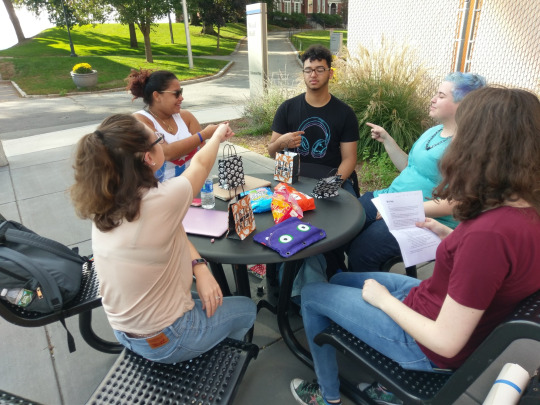
Things I changed after this playtest was that the ghost couldn’t steal from a player on the last round to prevent it from being impossible for all players to win. Also, I need to still work on streamlining the instruction page. The game isn’t super complicated as a whole but it seems that the rules as is are hard for players to grasp before they start playing. I had a lot of fun seeing new players try my game.
0 notes
Text
Assignment 10.2: In-Class Testing
Once I bounced around a few mechanics I did a playtest with members from our class, some of which who haven't played the game before. I added a mechanic that the ghost would steal from two players of their choice if nobody pointed at anybody as a way to encourage players to point at each other each round. I was a bit stuck with how to progress with the game but this group of players provided many good ideas for me to work with such as:
a player becoming a ghost when they run out of candy
players being able to vote to reveal someones candy during the game
player trading
reveal information based on a die roll
stealing mechanic
a timer
Sadly I forgot to take a picture of this playtest, but here is the core mechanic visualization so far.
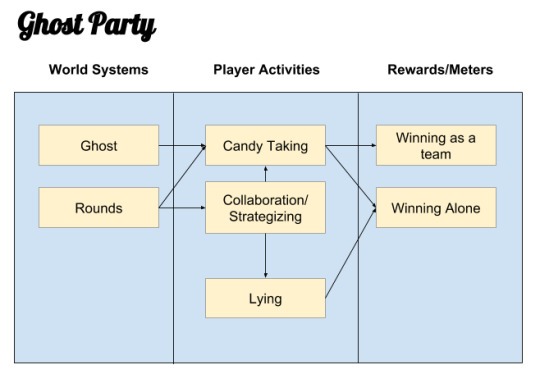
0 notes
Text
Assignment 10.1: Prototyping/Brainstorming
The game is being tentatively called Ghost House, and is the game that De’Ondre and I worked on for the 15 minute game assignment. All of the initial prototyping was done during that period, and the game went through several micro-iterations such as slight numerical tweaks and otherwise.
To begin this project I first took what we learned from the initial playtest for the 15 minute game assignment and thought of what I could change to make the game slightly more in depth and interactive. My main design philosophy was to keep the game bloat free and streamlined while allowing as much player interaction as possible. It is a game that revolves around social play; discussing strategies, bluffing/lying, and betrayal are all fun aspects of the game that I want to facilitate. The fun of the game mostly depends on the social dynamics of the players, so I felt the best way to facilitate fun would be to create more opportunity for meaningful player interaction. A few ideas I bounced around included:
player stealing from another player
more ghost interaction
more information being revealed to the players by the ghost
Here is the picture from the 15 minute game jam:
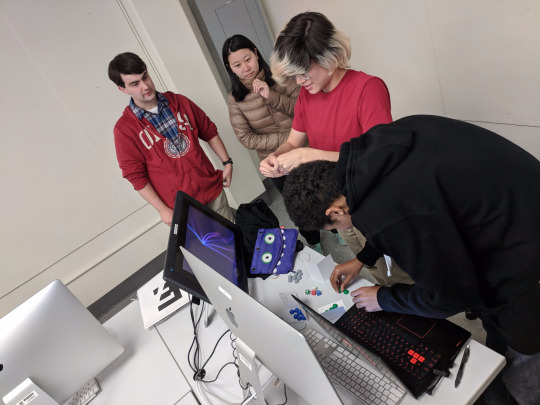
0 notes
Text
Assignment 9: 15 Minute Game
De’Ondre and I made a game about children trapped in a haunted house with a ghost who wants to take their candy. Everyone has a share of 8 pieces of candy (the candy bag is hidden from all other players). The goal of the game is to survive the night with the most candy. All players can win if everyone cooperates, but the game facilitates betrayal. If one person has more candy than anyone else at the end of the round, they take all the candy. In a round everyone closes their eyes and points at either nobody, or the person they want the ghost to visit. The ghost takes a piece of candy from everyone pointed at, and when everyone opens their eyes the ghost tells how many pieces of candy were stolen. Nobody can see eachothers candy bag, so players can lie about how many pieces they have (ie, to make people think that they are losing so they wont be targeted). The players have a chance to discuss strategy before going to the next round, and after 6 rounds all players reveal their candy bags.
As far as changes go we messed around with mechanics such as having a coin flip to have 1 or 2 pieces taken from each player pointed at, or for the ghost to announce how many players were stolen from at the end of each night. In the end the game was a fun competitive/cooperative game of bluffing your way to win, or by trying to work together as a team to win.
(we don’t have any pictures sadly) edit: thanks to Misha for snapping a pic of the game, here it is
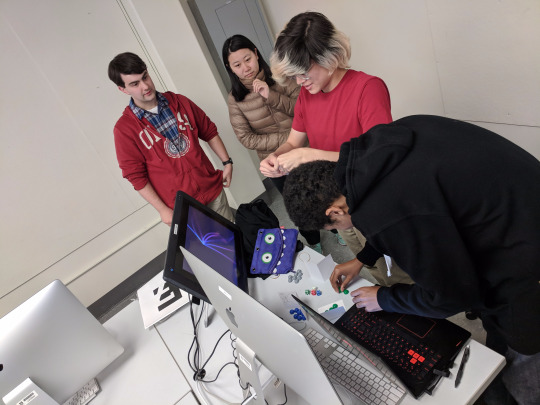
0 notes
Text
Assignment 7: Up the River Prototype
Pirate Waterfall: fight and race against another team of pirates to make it first to the fountain of youth. What we changed: We added a card based combat mechanic. When you land on a tile with another players ship you can choose to fight them, each player playing a card from their hand. The player with the lower number moves back a space. Cards are a limited resource, and you can draw one by rolling a 1 on the die. This gave the game a much different competitive edge, and with ships being sent back they are more likely to fall off the edge of the map (the waterfall). We chose to graft on a theme of pirates fighting each other on top of the original river theme.
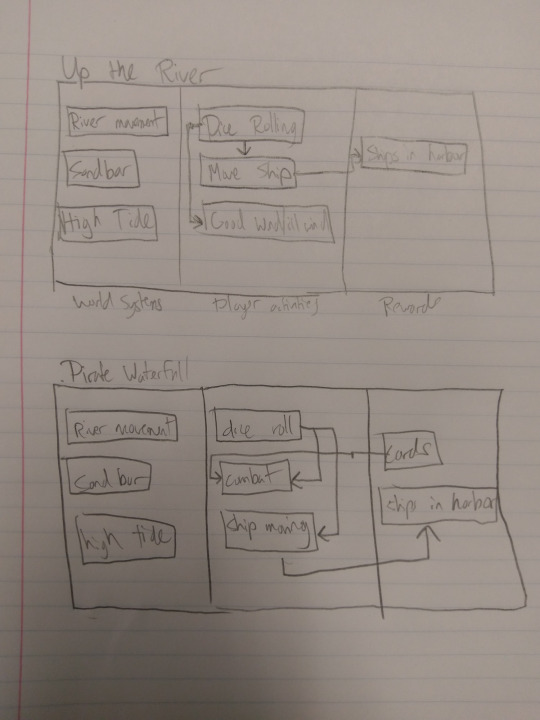
0 notes
Text
Assignment 6: Prototyping 101 Notes
methods of prototyping
many different types of prototypes, a single project might require a number of different prototypes
important to remember you are not creating final design, but trying to formalize your ideas to discover what works.
physical prototypes are easiest type for most game designers
allows you to focus on gameplay rather than the technology
making changes to pen + paper is easier than making changes to code (turn structure, mechanics, units, etc)
allows for nontechnical team members to participate in design process
many famous electronic games are based on paper games
even valuable for games that may seem unable to be physically prototyped
for example, while you can’t accurately reflect the gameplay of a first person shooter, a paper prototype can help you think of the core design of the game
1 note
·
View note
Text
Assignment 5: Modifying Carcassonne
We decided to modify Carcassonne. Our overall goal was to make the game shorter and more compact. At first we tried removing certain tiles from the game. We split into two groups of one-on-one, one group only had city tiles and the other only had roads. We both found that the games were shorter, but far less dynamic and simply less fun to play. We tried changing other elements such as number of meeples, but in the end the underlying problems still remained. The rule we settled on and found to be fun after playtesting was a score cap. Usually the game ends after all tiles are expended, but instead we created a rule that whoever reached 25 points first would win. While the game wasn’t too much shorter overall, the dynamics that arose from the game we found to be very fun. Instead of playing the rest of the tiles just because that was the rule of the game, we felt much more under pressure and always one or two tiles away from building the structure that would push us past 25 points. We could play with the score cap to make the game shorter, such as a cap at 15 or 20, but the score cap in general introduced some interesting dynamics.
0 notes
Text
Assignment 3: Carcassone vs. 7 Wonders
Of the games I played in class, I will be comparing Carcassone and 7 Wonders. Both are similar in that you are pitted against a number of players. In 7 Wonders, each turn you choose a card to play to build up your board, and in Carcassone you draw a tile to place on the map to create a sprawling city. Both games allow interaction and helping/hindering other players, however Carcassone does somewhat allow for more consistent direct intervention as you all share a single board, rather than separate boards as in 7 Wonders.
Carcassone: Agon (contest): 4 Alea (chance): 4 Ilinx (vertigo): 0 Mimicry (make-believe): 4.5 Paidia <------()----------> Ludus
7 Wonders: Agon (contest): 3.5 Alea (chance): 2 Ilinx (vertigo): 0 Mimicry (make-believe): 3 Paidia <-----------()------> Ludus
0 notes